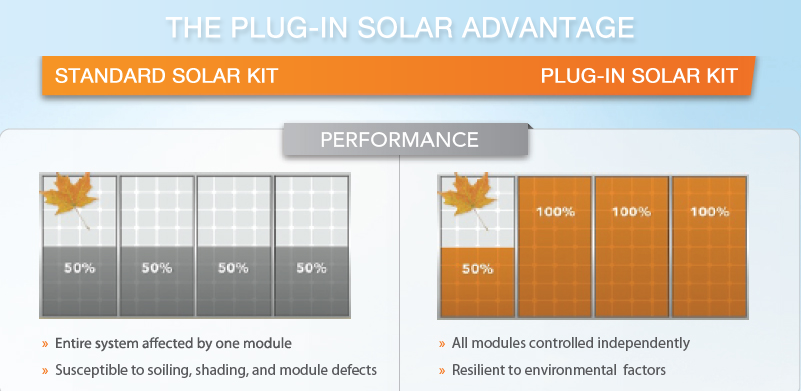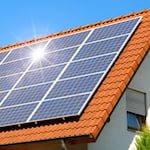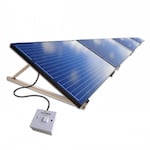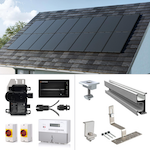Plug-In Solar is a Do It Yourself (DIY) solar power system, which allows you to generate your own free electricity that you can use to power your appliances. Plug-In Solar kits include all you need to start saving money on your electricity bills, without the need for government incentives, such as the Smart Export Guarantee.
Plug-In Solar has a number of advantages over a ‘conventional’ solar system:

Low Cost – Small Investment

No Labour Costs – Do it Yourself

Simple DIY Assembly with No Experience Required (All AC wiring)

No EPC Inspections Necessary

No MCS Certification Required

Plug-In Solar can be expanded at any time

Choose your own location for your Plug-In Solar installation
The electricity generated by the solar panels is fed (via the Micro-Inverters) directly into your mains electrical grid on the load side of the meter. The Micro-Inverters slightly exceed the national grid voltage in order to push the current to your mains grid. When there is solar energy being produced, the national grid recognises that no power is required, until the voltage from the Inverters drop again, at which point the National Grid provides the power. This means the appliances will always use the energy generated by the solar panels first, before going to the National Grid.
If you are using more energy than you are generating, the solar kit will provide as much energy as it can and the remainder will be supplied by the grid. In the event you are generating more energy than you are using, this excess energy will be sent back to the National Grid. This is completely normal, and legal. The two energy sources work in harmony, without any manual switching required. By reducing your electricity use in this manner, you save money on your energy bills.
There are 3 key areas to consider when choosing the correct size Plug-In Solar Power kit.
- How much electricity do you / will you use?
- How big is the area where the panels will be installed?
- Your budget?
How much electricity do you / will you use?
The most reliable point of reference for a retrofit solar kit will be the existing electricity bills for a property. Each home has a ‘base load’, which is the amount of energy used in an average day/week/month to power all the appliances in the property. You can work this out for your property by looking at your own electricity bills, or keeping records using your electricity meter.
According to OFGEM, an average household with medium energy consumption uses between 3200 and 4200 kWh per annum.
Taking the higher end of this scale (4200kWh) and dividing by 12 (for months of the year), the result is an average 350kWh per month. Let’s assume you wish to cover 50% of your energy usage, so 175kWh per month.
You will then need to know the average kWh per month each Plug-In Solar Kit generates. This information can be found in the downloads section of each Plug-In Solar Kit listing.
A 250W Plug-In Solar Kit generates approximately 245kWh per year, that’s an average of around 20kWh per month.
This would mean that 9 x 250W solar panels, making up a 2.25kW (2250W) Solar Kit, are needed to cover an estimated 50% of the total average electricity costs for the example household. (9 x 20kWh = 180kWh per month).
How big is the area where the solar panels will be installed?
Plug-In Solar kits can be installed on tiled/slate or metal/wood pitched roofs, flat roofs, or on the ground. The number of panels you can install may be limited by this available area, but please ask us for help with designing your system, so we can help you achieve the biggest possible system for your needs.
What size solar power kit will fit the available budget?
Your budget will ultimately dictate the size of the solar panel kit that can be purchased. A lower budget will require a compromise on the number of panels you can install. This means that the percentage of the energy costs covered by the panels will also be lower, but you will still make savings.
As Plug-In Solar kits are modular in nature, it is possible to buy the kits incrementally, starting off small and building up a to bigger kit. This also helps spread the cost across a few months/years. However, if the budget is higher and space allows, it is worth considering increasing the number of solar panels. This will maximise the levels of energy that the solar panels will generate for the property, resulting in bigger savings.
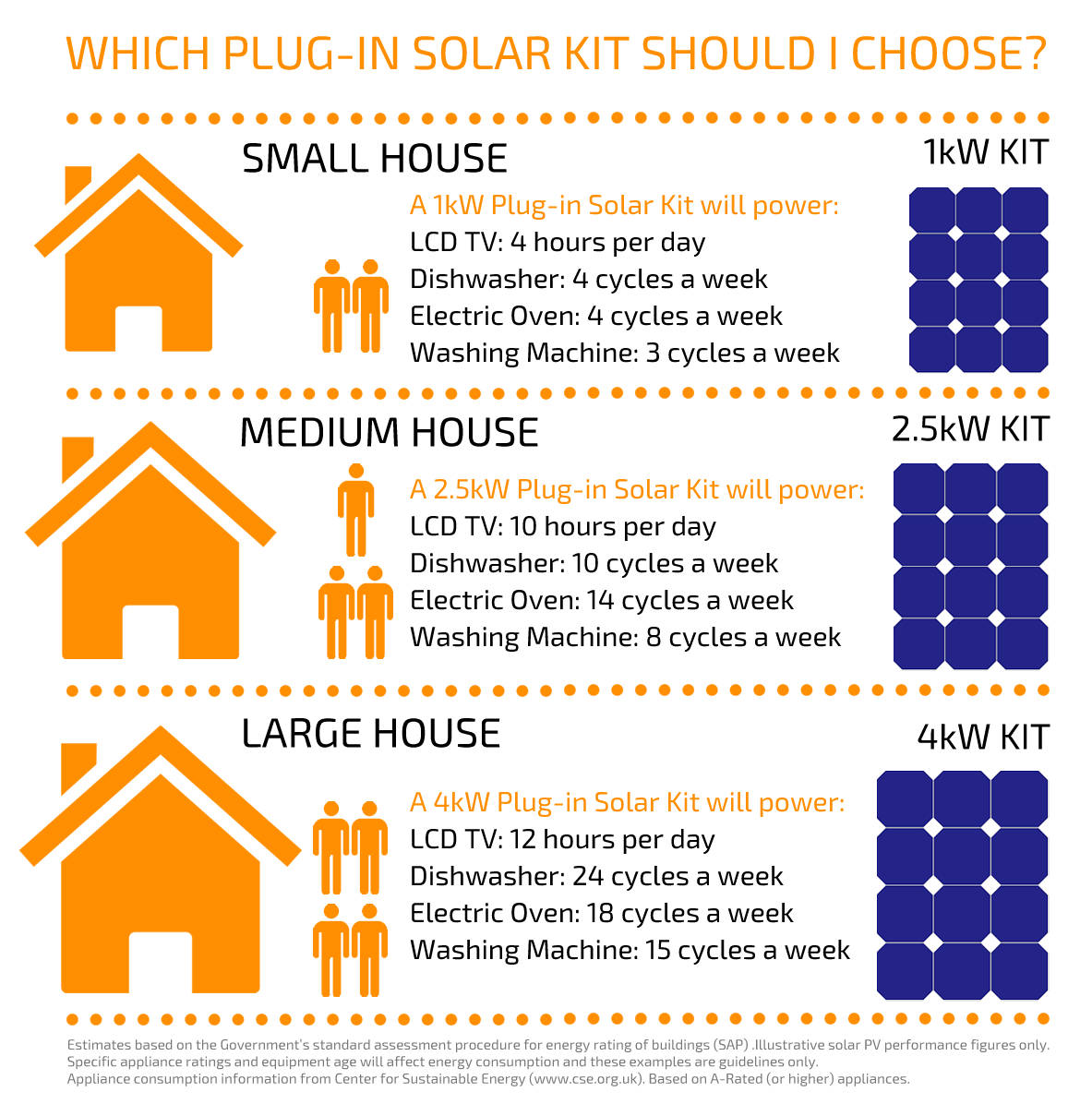
No. Plug-In Solar Kits, are Grid-Tied Solar Kits, and therefore require an active 230V/50Hz mains grid in order to operate.
If you are interested in purchasing an Off-Grid Solar Kit, please Contact Us for help with design and quotations.
The bigger the Plug-In Solar kit, the bigger the saving. As an example, the total savings over a 20-year period on a 1kW (1000W) Plug-in Solar kit could be over £7,687.00. This equates to an average saving of over £384.00 per year over the 20-year period**
More information on these calculations can be found here.
The bigger the kit, the bigger the energy saving. As an example, on average, a 1kW (1000W) Plug-In Solar Kit (which consists of 4 x 250W panels) will produce enough energy, in one year, to power***
| Washing Machine |
Fridge Freezer |
LCD TV |
Tumble Dryer |
2.5 times per week
(130 times per year) |
24 hours per day
(for 365 days per year) |
5 hours per day
(for 365 days per year) |
2.5 times per week
(130 times per year) |
More information on these estimates can be found here.
Any excess electricity generated by a Plug-In Solar kit and not used by appliances will be sent back to the National Grid. This happens automatically, and is completely normal and legal. If you have an old rotary meter it may spin backwards but newer meters sometimes flash red to indicate reverse power. This is normal but we advise informing your electricity supplier if you are installing a Plug-In Solar kit. We also sell energy saving devices to help you use your power more wisely, such as
Immersion Diverters. Please ask for more information.
Plug-In Solar kits are fully modular and upgradable. You can add to your Plug-In Solar kit by simply plugging the kits together. The system is completely adaptable to suit your needs for now and in the future. Just Plug and Play.
The Feed-In-Tariff was a government based scheme that applied to solar installations that were undertaken by MCS accredited installers. The Feed-In Tariff ended on 31st March 2019. The current Smart Export Tariff requires solar installations to be undertaken by MCS accredited installers. The components that make up the Plug-In Solar Kit have the relevant MCS accreditations and G98/99 Certifications to be suitable for an installation for the Smart Export Tariff , but these will need to be installed by an MCS accredited installer in order to apply for the tariff.
We offer a range of monitoring systems. Most allow you to monitor the production of your Plug-In Solar kit from anywhere (with internet access) and at anytime. Please contact us to discuss your requirements, or visit the
Monitoring Systems section of the website.
The Plug-in Solar guarantee is based on manufacturers standard warranties. These are 10 years for the Solar Panel (plus 20 year 80% power performance guarantee), 10 years for the Dual Micro-Inverter, and 10 years for the mounting system. All warranties are available on request.
The Plug-in Solar certifications are based on the manufacturers standard certifications. The Solar Panels and mounting system are MCS certified (Micro-Inverters do not require MCS certification) and the Solar Panels and Micro-Inverters are both G98/99 and CE certified (mounting systems do not require a G98 certification). All certifications are available on request.
The large majority of Plug-in Solar installations will not need planning permission as they fall under ‘permitted development’, unless the property is a listed building or is situated in a national park or area of outstanding natural beauty.
It is your responsibility to check whether or not you need planning permission for your solar installation. If in doubt contact the planning department of your local authority for more information, or visit the solar section of the planning portal here:
Planning Portal
Yes. Once you have installed, inspected and tested your Plug-In Solar kit, it is a requirement that you complete and return a G98 Engineering Recommendation Form to your Distribution Network Operator (DNO) within 28 days. You can find your DNO by entering your postcode using this website: https://www.ssepd.co.uk/Whoismynetworkoperator/
The Plug-In Solar installation manual provided with your kit will guide you through this process, and if you have any further questions, please do not hesitate to contact us.
The Plug-in Solar kits do not store any energy. When the sun is out the panels will supply energy to the house mains circuit and be used to help power appliances. In order to store any energy you would need a battery system. For more information, please visit the
Battery Systems section of this website. If you would like more detailed information on battery and energy management systems please contact us.
Plug-in Solar kits will turn off in the event of a power outage. This is to ensure that no power is being fed into the grid whilst it is inactive. This is a requirement under the G98 regulations.
Yes, but you must be aware of, and abide by, the local grid regulations in the country in which you are planning to use the Plug-In Solar kit. For example, The Netherlands and Switzerland both allow you to have up to 600W connected directly to an Electrical grid. In Portugal you are allowed up to 1.5kW (1500W) under what’s know as Self-Consumption, whereas in Spain you are limited on how much energy you can send back to the grid. Germany has much tougher VDE grid regulations which are dependant on each network operator. Please check with your network operators to find out the grid regulations in your country for Plug-In Solar.
You can pay by Paypal, Debit or Credit card in our online shop. You can also pay over the phone by calling 01444 672005, or by Bank Transfer using the details found on the Invoice issued to you.
We’ll be sending you your Plug-in Solar Kit by courier, safely packed on a Pallet. Please supply your phone number when you purchase your kit, as the courier may need to contact you. You’ll find all the parts along with easy-to-follow assembly instructions.
You can see all information related to returns and refunds here:
Returns Policy.
If you have any further queries about the Plug In Solar Kit, or any of our other products, please do not hesitate to contact us on 01444 672005 or
info@pluginsolar.co.uk.
*Non-notifiable electrical installation work must still be designed, installed, inspected, tested and certificated in accordance with BS 7671.
**Calculations undertaken using the government’s SAP calculator which are based on industry averages and are used for guideline purposes only.
***Appliance age and energy rating will affect energy consumption. These figures are based on estimates and are for guideline purposes only. Estimates are based on A rated appliances or higher. Appliance consumption information from Center for Sustainable Energy (www.cse.org.uk)

 Low Cost – Small Investment
Low Cost – Small Investment